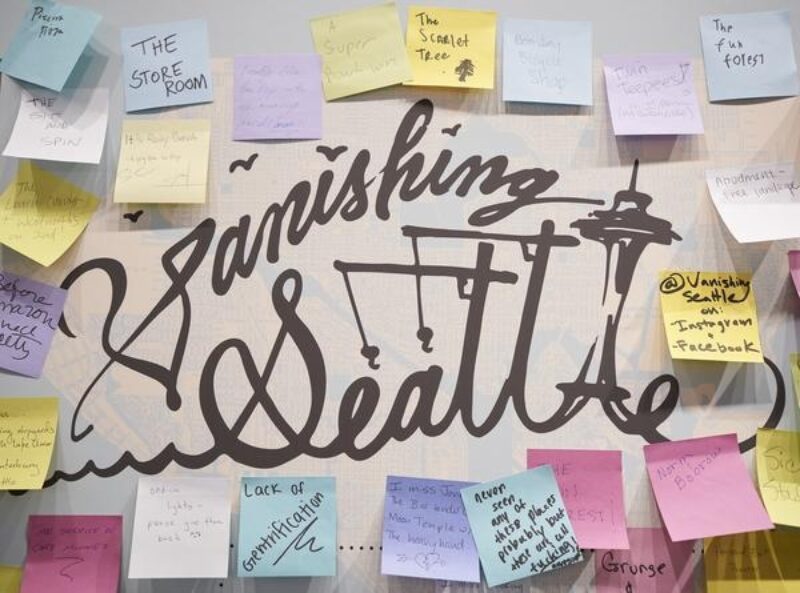Culture-Crushing Gentrification in Capitol Hill
Review of Vanishing Seattle film, screened at the Capitol Hill Arts District Streaming Festival
Written by TeenTix Newsroom Writer Maia Demar and edited by Teen Editor Tova Gaster

I’ve grown up with Capitol Hill. I went to daycare at Seattle Central College, elementary school at T.T. Minor, and came back full circle to Central for dual enrollment as a junior in high school. My dad works for The Stranger, right next to what used to be Value Village and what’s now a WeWork building. Even my aunt and uncle are Seattle artists, but they actually recently moved to Bremerton. For artists, the rising prices of gentrification have made it impossible for them to live on Capitol Hill. These cultural shifts in Seattle’s historic arts district are exactly what is discussed in Vanishing Seattle, a work-in-progress short film which was streamed digitally as part of the Capitol Hill Arts District Streaming Festival.
Vanishing Seattle is also a local movement documenting the increasing gentrification of Seattle, both on their website (vanishingseattle.org) and their popular Instagram account (@vanishingseattle). They post pictures of the displaced or diminished old Seattle, often those of artistic or cultural significance, in an effort to bring awareness to the incredibly gentrified condition of Seattle.

Capitol Hill is now thought of as one of the most desirable places on the West Coast to live. The Vanishing Seattle film, made by filmmakers Laura Jean Cronin and Angela Bernardoni, highlights the new level of class disconnect in the neighborhood. So many artists have had to leave their studios and homes on Capitol Hill because they could no longer sustain themselves there. It’s easy to connect the dots between the number of tech workers now living on the Hill and the number of people sleeping in Cal Anderson park. It would be one thing if contractors were building affordable housing for those who would be otherwise displaced, but they aren’t. Vanishing Seattle unabashedly calls out classism, and gives voice to the people it negatively affects.
This 30-minute documentary features Jeannine Powers (artist at Pound Arts), Adé A Cônnére (Seattle artist/performer), Catherine Nueva España (Executive Director of Velocity Dance Center), Amos Miller (musician and resident of LoveCityLove), Lucien Pellegrin (founder of LoveCityLove), Miki and Yuki Sodos (owners of Café Pettirosso), Vivian Hua (Executive Director of Northwest Film Forum), and more. Although their experiences differ, their feelings about how the Hill has changed are mutual: “It was a safe place for freaks, for people who are different,” states co-artistic director of Annex Theatre, Madison Jade Jones. The interviewees feel it’s less of a safe space now—there are so many unfamiliar faces and places on the Hill now that creatives and queer people no longer feel accepted or have the same connections.
The film begins by asking each of the interviewees what their take on the concept of “progress” is. The director’s decision to prelude the film with these interviews not only made for an interesting hook, it also relates wholly to the message of the documentary. Progress doesn’t have to be a binary positive or negative, as the “progress” Capitol Hill is undergoing is turning it into a whole new neighborhood, for better and for worse. While it’s now booming with millennials and profitable businesses, it’s also losing a lot of its original culture. Thirty years ago apartments could be rented for dirt cheap, there were plenty of old buildings with lots of light for studios, and lots of auto workshops without columns that could be used as dance studios. Today, apartments on the Hill go for $4,000 a month and building owners don’t want to sell their spaces to artists because it doesn’t appeal to the current economic demographics of the Hill. While powerful businesses and expensive living surge forward, the artists who brought the Hill into fruition in the first place are left behind. Vanishing Seattle’s general consensus about Capitol Hill is that gentrification crushes culture.

Owen Connell, owner of the tattoo and art studio, Parlor-F, has known my parents for almost 20 years. He’s done a majority of their tattoos. After seeing him in Vanishing Seattle’s work-in-progress episode during Capitol Hill Arts Fest, I wanted to hear more about how gentrification in his neighborhood impacted him. One of his quotes from the film really stood out to me: “I used to see people I knew everywhere I went; now I could go two weeks without seeing anyone I know,” so I called and asked him to elaborate. When I asked about how his building in particular would be affected by gentrification, he didn’t seem too hopeful. “I moved into this building in ‘89 and have been here since. It’s 110 years old. [...] I thought my building would’ve been torn down 15 years ago. For some reason, the owner hasn’t decided to yet.” Connell is lucky, many of his friends can’t say the same. He does have conviction that some of the old Capitol Hill will be preserved though. “I think there’s still hope. Half of the buildings [on the Hill] are new, and half are the old, funky buildings. Buildings like the Wildrose and the Comet are still here,” Connell says. However, due to COVID-19, many restaurants and businesses have already been closed since mid-March, and without the stream of customers, they won’t last much longer. “Fingers crossed that places will slowly open back up,” Connell tells me, “tattooing might be opening on June 1. We’ll see…” Either way, the film paints a distinct and necessary picture of the current and ongoing scene on Capitol Hill.
When asked what could be done to maintain what’s left of the old Capitol Hill, everyone in the film had the same ideas. Keeping the Hill a safe space for LGBTQ+, POC, and artistic culture is at the top of their lists. Artists need to gain control and become activists in their community. They need to voice their opinions and use art as a universal voice more than ever, because Capitol Hill without artists and dreamers is no longer Capitol Hill. They need to put a stop to the blurring line between art movements and art markets, because art markets don’t save the world. A stereotype about artists is that we’re poor and powerless, but we can’t let that decide the future of Capitol Hill. As Lucien Pellegrin questions, “We’re creative, so why are we settling for these losses?”
The Capitol Hill Arts District Streaming Festival ran online from April 29-May 3, 2020. The Vanishing Seattle film was screened on Sunday, May 3, alongside work from Toe Jam, MIPoPS, Longhouse Media, & Velocity Dance Center.
Lead photo credit: Vanishing Seattle logo, photo by Cynthia Brothers.
The TeenTix Newsroom is a group of teen writers led by the Teen Editorial Staff. For each review, Newsroom writers work individually with a teen editor to polish their writing for publication. The Teen Editorial Staff is made up of 6 teens who curate the review portion of the TeenTix blog. More information about the Teen Editorial Staff can be found HERE.
The TeenTix Press Corps promotes critical thinking, communication, and information literacy through criticism and journalism practice for teens. For more information about the Press Corps program see HERE.


